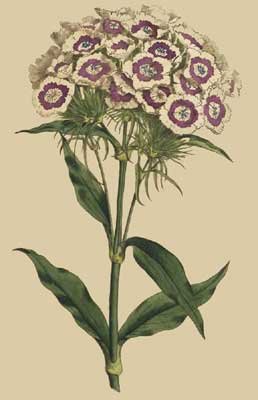Dianthus Barbatus
Flowers

Dianthus Barbatus
Linn?us, in his Spec. Pl. appears not to have known of what country the Sweet William was a native, and even in the Hortus Kewensis, this circumstance is left undecided, yet Dodon?us, in his Pemptades, mentions its being found wild in Germany, and Prof. Hoffman confirms this in his Germanys Flora.At the time Dodon?us wrote (1552) this plant was cultivated in the Netherlands, from whence it was probably introduced to this country, where it certainly is one of the oldest inhabitants of our gardens.Beautiful as are the numerous varieties of this species of Dianthus, Florists have not deemed it worthy of that peculiar attention which they have bestowed on its more favoured relatives the Pink and Carnation, and hence it probably has not arrived at that degree of improvement of which it is capable, our figure is intended to represent one of the most esteemed of its kind, viz. the Painted Lady variety, which has a deep rich purple eye, surrounded with a pure white, having the edge of the petals slightly indented, but our colours fall far short of the beauties of the original.
Besides single flowers producing an infinite variety of colours, there are several double varieties of the Sweet William, some of which are observed to have more scent than others.To possess these plants in perfection, we must renew them yearly, for though the root be perennial, it is apt to decay, especially if the soil in which it grows be either very moist, or very dry, or if the air be not pure, the single sorts must be raised from seeds, which should be saved from the choicest flowers, the double sorts may be increased by cuttings, pipings, or layers, in the same manner, and at the same time as Pinks and Carnations, the seed should be sown early in April, the seedlings transplanted into a bed in June, taking advantage of a wet day and placed about six inches asunder each way, in September they will be fit to transplant into the flower border, where they will blossom the ensuing summer, during the months of June and July, and ripen their seed in August.
 Viola Pedata
Viola Pedata Iris pumila Dwarf Iris
Iris pumila Dwarf Iris Glycine Bimaculata
Glycine Bimaculata Gorteria Rigens
Gorteria Rigens Amaryllis Atamasco
Amaryllis Atamasco Campanula Grandiflora
Campanula Grandiflora Salvia Aurea
Salvia Aurea Leucojum Vernum
Leucojum Vernum Amaryllis Vittata
Amaryllis Vittata Tagetes Patula
Tagetes Patula Michauxia Campanuloides
Michauxia Campanuloides Saxifraga Crassifolia
Saxifraga Crassifolia Test your English Language
Test your English Language  Unique Potato Chips Flavors
Unique Potato Chips Flavors Healthy Throat
Healthy Throat Summer Health Foods
Summer Health Foods Benefits of Mangoes
Benefits of Mangoes Best Places to Celebrate Xmas
Best Places to Celebrate Xmas The Crocodile and Monkey
The Crocodile and Monkey Terrifying Rulers of The Underworld
Terrifying Rulers of The Underworld




